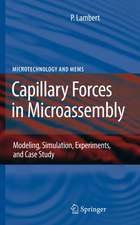Surface Tension in Microsystems: Engineering Below the Capillary Length: Microtechnology and MEMS
Editat de Pierre Lamberten Limba Engleză Hardback – 10 sep 2013
The originality of this book is to consider the effects of capillary bridges on solids, including forces and torques exerted both statically and dynamically by the liquid along the 6 degrees-of-freedom.
It provides a comprehensive approach to various applications, such as capillary adhesion (axial force), centering force in packaging and micro-assembly (lateral force) and recent developments such as a capillary motor (torque).
It devises how surface tension can be used to provide mechanical functions such as actuation (bubble-actuated compliant table), sealing and tightness, energy harvesting, nanodispending.
| Toate formatele și edițiile | Preț | Express |
|---|---|---|
| Paperback (1) | 1001.95 lei 6-8 săpt. | |
| Springer Berlin, Heidelberg – 27 aug 2016 | 1001.95 lei 6-8 săpt. | |
| Hardback (1) | 1007.35 lei 6-8 săpt. | |
| Springer Berlin, Heidelberg – 10 sep 2013 | 1007.35 lei 6-8 săpt. |
Din seria Microtechnology and MEMS
- 18%
 Preț: 969.44 lei
Preț: 969.44 lei - 18%
 Preț: 947.04 lei
Preț: 947.04 lei - 18%
 Preț: 950.21 lei
Preț: 950.21 lei - 15%
 Preț: 638.24 lei
Preț: 638.24 lei - 18%
 Preț: 949.55 lei
Preț: 949.55 lei - 18%
 Preț: 948.16 lei
Preț: 948.16 lei - 18%
 Preț: 948.29 lei
Preț: 948.29 lei - 15%
 Preț: 641.38 lei
Preț: 641.38 lei - 18%
 Preț: 948.61 lei
Preț: 948.61 lei - 15%
 Preț: 649.06 lei
Preț: 649.06 lei - 15%
 Preț: 638.43 lei
Preț: 638.43 lei - 15%
 Preț: 637.59 lei
Preț: 637.59 lei - 15%
 Preț: 646.62 lei
Preț: 646.62 lei - 24%
 Preț: 800.57 lei
Preț: 800.57 lei - 15%
 Preț: 640.88 lei
Preț: 640.88 lei - 18%
 Preț: 953.65 lei
Preț: 953.65 lei - 18%
 Preț: 952.09 lei
Preț: 952.09 lei - 18%
 Preț: 954.62 lei
Preț: 954.62 lei - 18%
 Preț: 948.79 lei
Preț: 948.79 lei - 18%
 Preț: 1217.41 lei
Preț: 1217.41 lei - 15%
 Preț: 642.51 lei
Preț: 642.51 lei - 18%
 Preț: 1007.35 lei
Preț: 1007.35 lei - 18%
 Preț: 1002.75 lei
Preț: 1002.75 lei
Preț: 1007.35 lei
Preț vechi: 1228.47 lei
-18% Nou
Puncte Express: 1511
Preț estimativ în valută:
192.76€ • 206.12$ • 160.72£
192.76€ • 206.12$ • 160.72£
Carte tipărită la comandă
Livrare economică 18 aprilie-02 mai
Preluare comenzi: 021 569.72.76
Specificații
ISBN-13: 9783642375514
ISBN-10: 3642375510
Pagini: 450
Ilustrații: XXIX, 327 p. 174 illus., 42 illus. in color.
Dimensiuni: 155 x 235 x 27 mm
Greutate: 0.66 kg
Ediția:2013
Editura: Springer Berlin, Heidelberg
Colecția Springer
Seria Microtechnology and MEMS
Locul publicării:Berlin, Heidelberg, Germany
ISBN-10: 3642375510
Pagini: 450
Ilustrații: XXIX, 327 p. 174 illus., 42 illus. in color.
Dimensiuni: 155 x 235 x 27 mm
Greutate: 0.66 kg
Ediția:2013
Editura: Springer Berlin, Heidelberg
Colecția Springer
Seria Microtechnology and MEMS
Locul publicării:Berlin, Heidelberg, Germany
Public țintă
ResearchCuprins
Part I Physical Background.- Part II Static Modelling of Capillary Forces and Torques.- Part III Dynamic Modelling of Capillary Forces.- Part IV Case Studies. Part V Conclusions and Perspectives.
Textul de pe ultima copertă
This book describes how surface tension effects can be used by engineers to provide mechanical functions in miniaturized products (<1 mm). Even if precursors of this field such as Jurin or Laplace already date back to the 18th century, describing surface tension effects from a mechanical perspective is very recent.
The originality of this book is to consider the effects of capillary bridges on solids, including forces and torques exerted both statically and dynamically by the liquid along the 6 degrees-of-freedom.
It provides a comprehensive approach to various applications, such as capillary adhesion (axial force), centering force in packaging and micro-assembly (lateral force) and recent developments such as a capillary motor (torque).
It devises how surface tension can be used to provide mechanical functions such as actuation (bubble-actuated compliant table), sealing and tightness, energy harvesting, nanodispending.
The originality of this book is to consider the effects of capillary bridges on solids, including forces and torques exerted both statically and dynamically by the liquid along the 6 degrees-of-freedom.
It provides a comprehensive approach to various applications, such as capillary adhesion (axial force), centering force in packaging and micro-assembly (lateral force) and recent developments such as a capillary motor (torque).
It devises how surface tension can be used to provide mechanical functions such as actuation (bubble-actuated compliant table), sealing and tightness, energy harvesting, nanodispending.
Caracteristici
Summarizes most recent developments and research results in surface tension for emerging industrial products Provides an original and comprehensive study of surface tension forces and torques including modeling, simulation, experimental set ups Contains many case studies including gripping, actuation, capillary filling, sealing, self-assembly, adhesion for better understanding Allows the direct use of the results for the simulation in nomograms and close packed formulas Provides learning help in exercises Includes supplementary material: sn.pub/extras

















